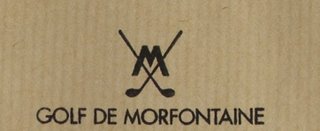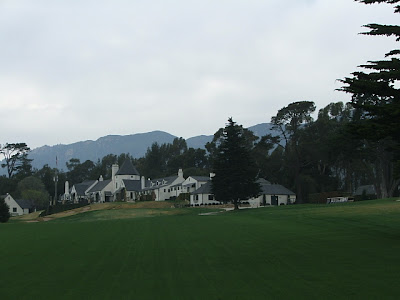
A brief update to let you know how I am fairing in my attempt to play the Golf Club de Morfontaine outside Paris. As my previous readers know, I was rebuffed in my initial attempts to gain access to this private club. Having learned that persistence is important in this quest, I am forging ahead with some more creative attempts to gain access. If you would like to read my original post on Morfontaine, click here.
So, I thought long and hard, who is the most famous of French golfers? Is it Arnaud Massy, who was the only Frenchman to win the Open Championship 1907 at Hoylake? Sadly, though, Arnaud died in 1950. Actually, the most famous French golfer alive is our infamous friend Jean Van de Velde, who was almost the second Frenchman to have won the Open Championship.
Bien Sur.
After some difficulty I was able to track down Jean Van de Velde's agent and will keep his identity confidential for reasons that will soon be obvious. His English wasn't bad, if a bit heavily accented. After offering my condolences on Jean's performance at the 1999 Open I politely asked him if Jean might be so kind as to help me gain access to play Morfontaine.
Well, he did not directly answer my question. He went on a tirade against America being a land of over-indulgent people living in a crime-ridden, war-mongering society where people are self-centered, eat too much fast food, have an abundance of consumer products and lack sophistication and culture. I tried to identify the source of his anger, but it appeared deep-seated. At this point, I felt I had nothing to lose and suggested an "au contraire", and returned fire along the lines that the French are a bunch of womenizing prima-donnas that have strong body odor and drink too much wine, go on strike too much and are angry with us because we make better movies than they do, when suddenly the phone connection went dead. Perhaps the satellite connection was poor?
Allo...Allo...
Merde...
Perhaps it was a mistake to start the conversation off bringing up Jean's meltdown at Carnoustie? I'm having trouble with the nuances of dealing with the French.
I was brought up to believe that the U.S. and France were allies. My feeling was that it wouldn't be too difficult for a visiting American to arrange a game at Morfontaine. What surprised me about this episode is the hostility the French have toward Americans. Are we Americans not bosom buddies with the French? Permanent members of the U.N. Security Council together? We're both members of the nuclear club? Do we not help each other out in times of need? They helped to fund our war of independence and we helped liberate them in 1944. I don't understand how they're not being more receptive to my inquiries.
Sacre bleu...
I also got up the nerve to again call the club directly to see if they might have softened their previously rigid stance on overseas visitors. Maybe they couldn't hear us clearly last time. I thought I would speak louder this time and see if it made any difference.

It didn't. My latest attempt went pretty much like my first. In fact, probably worse. This time, I thought I heard sounds in the background of a blade being sharpened. Could it be they are readying the guillotine at Morfontaine for this obnoxious American?
"Jacques, if he calls again, it's off with the head!"
Rumor has it that both the members and the Fédération Française de Golf have now been notified about this enfante terrible trying to get access to their sacred course and have been warned not to take my calls!
All their attempts to keep me out of the club are going to be about as effective as the Maginot Line was at keeping out the Germans.
In golfing lore, the toughest secretary (as they call managers of clubs in Europe) is allegedly at Muirfield in Scotland. Stories of Muirfield secretaries' cool receptions and methods of turning away visitors are the stuff of legend. Morfontaine apparently can join the running among the ranks of courses that are difficut to gain access to. Their club history recounts the story of a famous partner in a London law firm who is near the club one day and goes inside to see if he can play. He is rebuffed (I know the feeling) and as he is leaving, sees one of the founders of the club and a member of the British aristocracy, Lord Parnham. He tells Lord Parnham how he has always dreamed of playing at Morfontaine and wonders if he could allow him to play as his guest. The Lord asks his credentials and he explains that he is a practicing member of the Church of England; went to Eton, graduated from Oxford, Magna cum Laude where he played four sports; served as a Captain in the Coldstream Guards where he won the Distinguished Service Order, Military Cross and Legion of Honor; fought at Dunkirk, El Alamein, Normandy and Arnhem. Since the distinguished gentleman helped liberate France, they let him play.
But only nine holes!
If an Oxford educated war hero only gets to play nine holes, my chances are probably pretty slim, but I am not giving up. I remain indefatigable in my quest.
The Golf Course and Architect
Morfontaine was the brainchild of a member of the French aristocracy, The Duc de Gramont. In the interest of historical accuracy, since there have been fourteen holders of this title since 1643, it was the 12th Duc - Antoine Agnor Armand de Gramont, Duc de Gramont, who lived from 1879 until 1962. He was a keen golfer and wanted a world class course near his estate, Château de Valliere. He chose Tom Simpson as the architect for his dream course.
Anyhow, given my obsessive personality, in the absence of playing the course, I have been doing some research on Tom Simpson, who can best be described as an iconoclast. He frequently wore a cloak and beret and was driven around in a silver Rolls-Royce (he is pictured below).

Simpson sounds like my kind of guy. Apparently, he had a flair for the dramatic. He once drove his Rolls-Royce slowly up and down in front of a club committee's window as they deliberated whether to accept his design as an architect. He also was on record as saying that no golf hole could be truly great unless it began to operate in the player's mind for some time before he actually came to it. He was also quoted as saying that "the vital thing about a hole is that it should either be more difficult than it looks or look more difficult than it is. It must never be what it looks." He liked his courses to demand 'mental agility'. All this research continues to build up my desire to get access to Morfontaine and see Simpson's masterpiece.
My exhaustive research also led me to the fact that fellow American and golf course architect Kyle Phillips (designer of the world ranked #65 course Kingsbarns) was hired to make changes to this French gem of a course within the last ten years.
Perhaps Mr. Phillips will take my call?
Or perhaps the current title holder, the 14th Duc de Gramont, whose grandfather founded the course can help, if I appeal to his sense of noblesse oblige?
I'll let you know how I make out...















